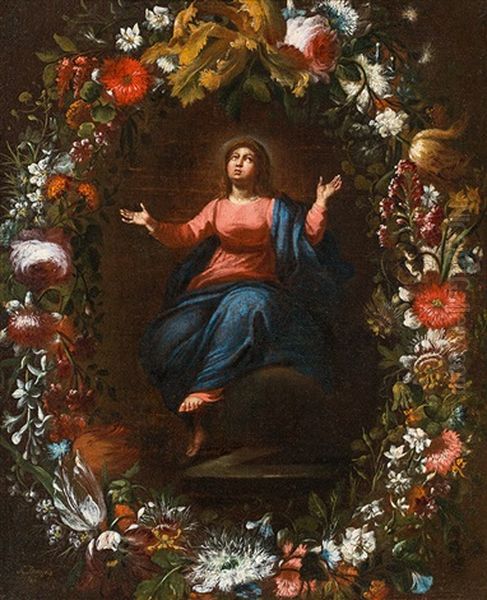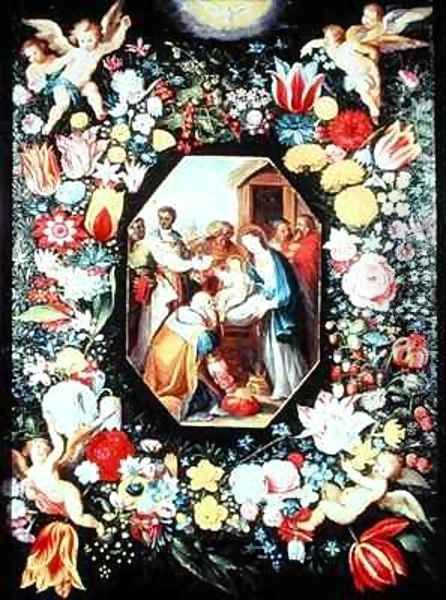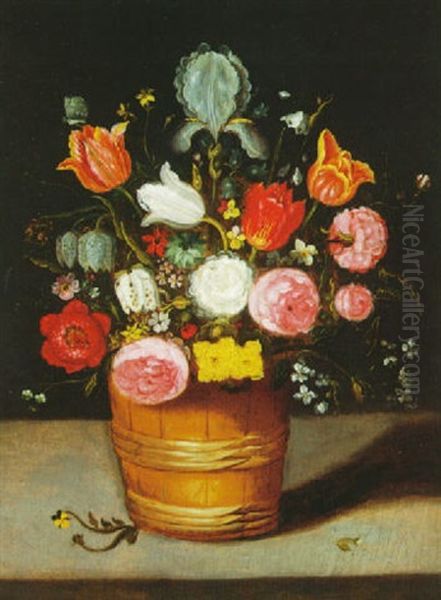Andries Daniels (circa 1580 – 1640) was a distinguished Flemish painter active primarily in Antwerp during the late 16th and early 17th centuries. He carved a significant niche for himself within the burgeoning field of still life painting, specializing particularly in the depiction of flowers and contributing notably to the unique genre of garland paintings. Though details of his life remain somewhat scarce, his artistic output and collaborations place him firmly within the vibrant artistic milieu of Antwerp's golden era.
Early Life and Artistic Formation
Historical records indicate that Andries Daniels likely began his artistic journey in Antwerp. A pivotal moment in his early career occurred in 1599 when he was registered as a pupil of Pieter Brueghel the Younger in the records of the Antwerp Guild of Saint Luke. This apprenticeship placed him under the tutelage of a prominent member of the famed Brueghel dynasty, known for their detailed landscapes and genre scenes. Pieter Brueghel the Younger himself was the son of the legendary Pieter Bruegel the Elder and brother to Jan Brueghel the Elder, another highly influential painter renowned for his floral still lifes and detailed allegorical scenes.
Daniels' training under Pieter Brueghel the Younger would have exposed him to the meticulous techniques and compositional strategies prevalent in Flemish painting at the time. After approximately three years of apprenticeship, Daniels achieved the status of an independent master, registering with the Guild in 1602. This marked the official commencement of his professional career, allowing him to establish his own workshop and take on commissions.
Artistic Style and Specialization
Daniels quickly established himself as a specialist in flower painting. His works are characterized by a high degree of naturalism and meticulous attention to detail. He rendered flowers with botanical accuracy, capturing the delicate textures of petals, the subtle variations in colour, and the play of light on leaves and stems. His compositions are often dense and complex, featuring abundant bouquets arranged in vases or woven into elaborate garlands.

His style reflects the broader trends in early Baroque Flemish still life, moving towards richer colours, more dynamic arrangements, and often, a greater sense of abundance compared to the more austere compositions of earlier Netherlandish still life painters like Ambrosius Bosschaert the Elder. Daniels demonstrated a keen understanding of different flower species, often depicting tulips, roses, irises, carnations, and other blooms popular in the gardens and markets of the time.
The precision in his work suggests careful observation from life, a hallmark of the period's growing interest in the natural world. While his primary focus was flowers, these were often imbued with symbolic meaning, drawing on established traditions where specific blooms could represent concepts like purity (lilies), love (roses), or transience (fading flowers or insects).
The Genre of Garland Painting
A significant aspect of Andries Daniels' oeuvre involves his contribution to the genre of garland painting (Dutch: 'bloemenkransschilderij'). This distinctive type of painting typically features a floral garland surrounding a central image, which could be a devotional scene, a portrait, or an allegorical figure. The genre is often considered to have been pioneered or popularized in Antwerp by Jan Brueghel the Elder around the turn of the 17th century.
These paintings were particularly popular during the Counter-Reformation, serving as objects of devotion. The surrounding flowers, symbols of divine creation and natural beauty, were seen to honour and embellish the sacred image within. The contrast between the meticulously painted natural elements and the central figurative scene created a unique visual and symbolic dialogue.
Daniels excelled in this genre, often collaborating with other artists who specialized in figure painting. His skill lay in creating lush, vibrant, and compositionally balanced garlands that framed the central motif effectively, enhancing its spiritual or symbolic resonance.
Key Collaborations
Collaboration between artists specializing in different genres was common practice in 17th-century Antwerp, allowing for the efficient production of high-quality works combining diverse skills. Andries Daniels engaged in several significant collaborations, most notably with Frans Francken II.
Frans Francken the Younger (or II) belonged to another extensive Antwerp painting dynasty and was highly versatile, known for his small-scale historical, allegorical, and genre scenes. The partnership between Daniels and Francken proved particularly fruitful for garland paintings. Typically, Francken would paint the central scene – often a religious subject like the Madonna and Child or the Holy Family – while Daniels would meticulously render the surrounding floral wreath.

This division of labour allowed each artist to focus on their area of expertise, resulting in works of exceptional quality and detail. Their joint creations seamlessly integrated the figurative element with the opulent still life border, becoming highly sought-after pieces. Besides Francken, Daniels is also known to have collaborated with other figure painters, including Jacob Jordaens.
Notable Works
While a definitive catalogue raisonné remains challenging due to attribution issues, several key works are associated with Andries Daniels, often in collaboration:
_Vase with Tulips_ (c. 1620-1625): This work, now housed in the Bilbao Fine Arts Museum, is a prime example of Daniels' collaboration with Frans Francken II. It showcases a vibrant bouquet dominated by tulips, reflecting the burgeoning interest and speculative value associated with these flowers in the Low Countries during this period. The painting exemplifies the detailed rendering and rich colours characteristic of Daniels' floral style.
_Holy Family in a Garland of Flowers_ (c. 1618): Located in the State Hermitage Museum, St. Petersburg, this painting is another significant collaboration with Frans Francken II. Francken likely painted the central depiction of the Holy Family, while Daniels crafted the intricate and abundant floral garland surrounding them. This work was notably discussed by art historian Marie-Louise Hairs in 1925 and stands as a testament to their successful partnership in the garland genre.
_The Virgin Mary_: Described as featuring five oval, coin-like grisaille images depicting scenes from Mary's life (Annunciation, Nativity, Incarnation, Presentation in the Temple, Jesus among the Doctors), all surrounded by a floral garland. This complex composition served not only as a devotional piece but also carried Counter-Reformation symbolism, reinforcing Catholic Marian devotion through both the narrative scenes and the beauty of the surrounding natural world.
_Madonna in a Garland with Images of Four Apostles_: Housed in the Biblioteca Ambrosiana in Milan, this work follows a similar format, with a central Marian image framed by Daniels' floral artistry and further embellished with depictions of apostles, likely painted by a collaborator.
_Garland of Flowers_ (with Jacob Jordaens): Records indicate a collaboration where the prominent Antwerp painter Jacob Jordaens executed the central image, while Daniels was responsible for the surrounding flower garland. This partnership highlights Daniels' standing as a respected specialist sought after even by major figures like Jordaens, who himself was a leading master alongside Peter Paul Rubens and Anthony van Dyck.
The Significance of Tulips

Daniels painted during a period when tulips, recently introduced to Europe from the Ottoman Empire, were rapidly gaining popularity and becoming status symbols. His inclusion of various tulip varieties, often rendered with great care, reflects this contemporary fascination. Some art historians suggest that certain works involving Daniels might be among the earliest depictions of tulips in Netherlandish art.
These depictions occurred before the peak of "Tulip Mania" (roughly 1634-1637) but certainly during the flower's ascent in cultural and economic importance. The presence of rare and expensive tulip varieties in his paintings would have added to their allure and value for contemporary collectors, signifying wealth and sophisticated taste alongside any potential symbolic meanings (like transience or beauty's fleeting nature).
The Antwerp Art Scene
Andries Daniels operated within one of the most dynamic artistic centers in Europe. Early 17th-century Antwerp, despite political and economic challenges following the Dutch Revolt, experienced a remarkable artistic flourishing, often referred to as the Antwerp School's Golden Age. The Guild of Saint Luke played a crucial role in regulating the art market, training apprentices, and maintaining quality standards.
Daniels was a contemporary of giants like Peter Paul Rubens, Anthony van Dyck, and Jacob Jordaens. While his specialization differed from these masters of history painting and portraiture, the overall artistic environment was one of high skill, innovation, and intense production. He also worked alongside other still life specialists, such as Osias Beert, known for his meticulous breakfast pieces, and Clara Peeters, one of the few recognized female painters of the era, who also excelled in still life. The Brueghel dynasty, including Jan Brueghel the Elder and Jan Brueghel the Younger, continued to be influential, particularly in landscape and flower painting. David Teniers the Younger, another major figure, also emerged during this period.
Daniels' collaborations, particularly with the prolific Francken family workshop, situated him within a network of artistic exchange and production that characterized the Antwerp scene. His focus on floral still life contributed to the diversity and richness of the art produced in the city.
Attribution Challenges
Despite his recognized skill, attributing works solely to Andries Daniels can be complex. The collaborative nature of many garland paintings means his contribution is often intertwined with that of a figure painter. Furthermore, stylistic similarities exist between Daniels and other flower painters active in Antwerp, including his teacher Pieter Brueghel the Younger and perhaps even Jan Brueghel the Elder, whose "velvet" touch and encyclopedic approach to flowers set a high standard.
The lack of signatures on many works from this period, combined with workshop practices where assistants might replicate a master's style, complicates definitive attribution. Some scholars have suggested that certain works traditionally given to Daniels might, in fact, be by Frans Francken II (who also painted still lifes) or other lesser-known specialists like Philippe de Marly. Ongoing research and connoisseurship continue to refine our understanding of his specific contributions.
One anecdote mentions that some works previously attributed to Daniels were later reassigned, highlighting the fluidity and ongoing debate within art historical scholarship regarding attributions from this era. This uncertainty, however, does not diminish the quality of the works themselves or the importance of the floral genre Daniels specialized in.
Later Life and Legacy
Details about Andries Daniels' later life are sparse. The primary documented event is the joint will he made with Jozinetke van der Ho(e)re, presumed to be his wife, on July 25, 1640. This suggests he was likely in declining health, as he is believed to have died in Antwerp later that same year.
Andries Daniels' legacy lies in his contribution to Flemish still life painting, particularly his mastery of floral depiction and his role in producing high-quality garland paintings. His detailed, naturalistic, and often opulent floral arrangements exemplify the tastes of the early 17th century. Through his collaborations, he participated in a popular and distinctive genre that merged devotional or allegorical imagery with the beauty of the natural world.
His work stands alongside that of other key figures in the development of Flemish flower painting, influencing subsequent generations of artists who specialized in this field, such as the Jesuit painter Daniel Seghers (a student of Jan Brueghel the Elder, who became highly renowned for his garland paintings) and Jan Philips van Thielen. Daniels remains an important representative of the specialization and high level of technical skill that characterized Antwerp's artistic production during its Golden Age.
Conclusion
Andries Daniels was a significant figure in the specialized world of Flemish flower painting during the early 17th century. Trained within the influential Brueghel circle and becoming a master in his own right, he excelled in capturing the intricate beauty of flowers with remarkable detail and naturalism. His frequent and successful collaborations, especially with Frans Francken II, yielded some of the period's most characteristic and appealing garland paintings, merging devotional piety with the era's burgeoning appreciation for the natural world. Though overshadowed by contemporaries like Rubens or Van Dyck, and facing some attributional complexities, Daniels' dedicated focus on floral art contributed significantly to the richness and diversity of Antwerp's Golden Age of painting, leaving behind works that continue to delight viewers with their botanical precision and Baroque splendour.